From Cyberpunk to Biopunk – On Posthuman Technologies
This is the first Leverhulme Lecture, held at Anglia Ruskin University on Mar 16, 2022, that I have given during my Leverhulme Professorship at the University of Leeds. Here is the transcript, a video of me talking and the slides/videos that I have used. Hope you can piece something together from this.
Transcript
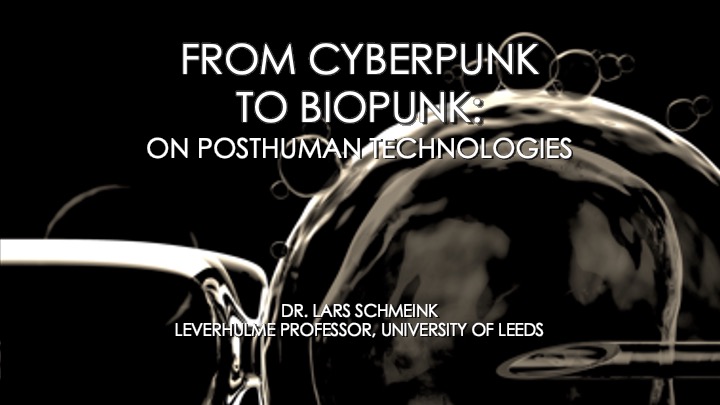
(1) Thank you for hosting me here at Anglia Ruskin and for the opportunity to share some of my work. My research is mostly on contemporary culture and how we as a society use popular culture to express our anxieties, our fears, our hopes of those technologies that are dominant in our life and those that might just be on the horizon for us. The posthuman is a term that has been used quite a bit to describe our current status of living with certain technologies and will – most likely – be used even more in the future.
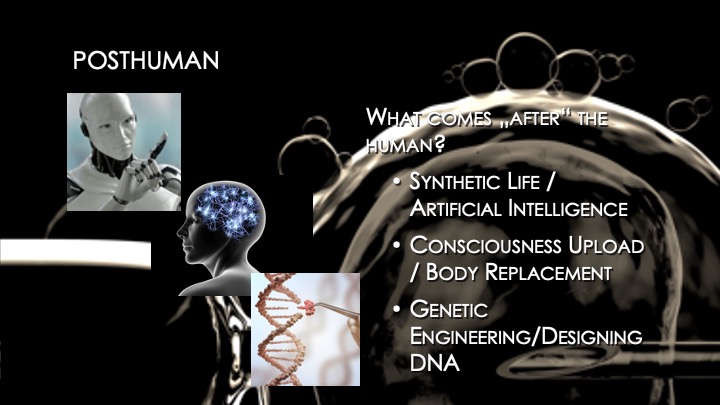
(2) So, when we talk about the posthuman, there are a few things that might need clarification. For many, it simply connotes that which comes after the human and describes a transformation in ontology. It might refer to us being able to create synthetic life by somehow having a fully realized artificial intelligence. It might mean that we will be able to – as transhumanist thinkers proclaim – leave behind our biological body, either by replacing it with other bodies or by fully uploading our consciousness into a computer. And lastly, of course, it might refer to our ability to manipulate DNA and creating new forms of human life or changing the one we have.
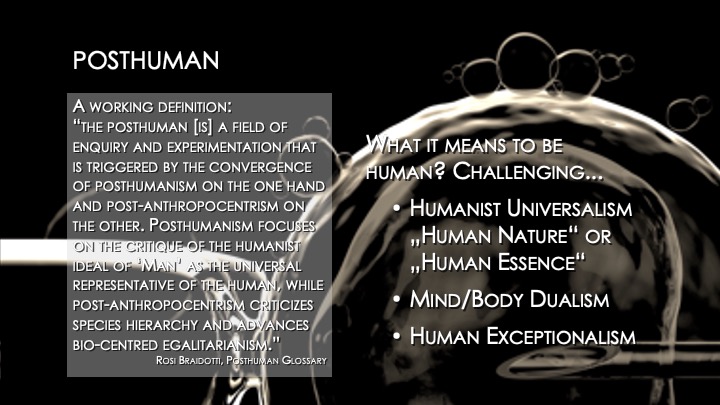
(3) Others argue, though, that the posthuman is more a cultural category. That it describes the way we perceive our existence and that it is linked to technologies that change and shape the way we are and the way we think. That it challenges the notion of a universal human nature. That it challenges the idea that only the mind determines the human as a category, that the body is mere shell to house us. That there is an essence or nature that defines what the human is. And that the human is exceptional in the sense of placing it in opposition to nature, the non-human or any other category.
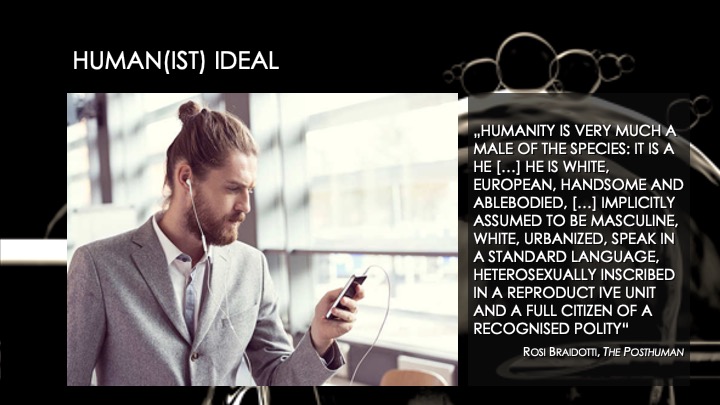
(4) What the posthuman thus challenges is the conception of the human as this — white, male, euro-centric, affluent, able-bodied …
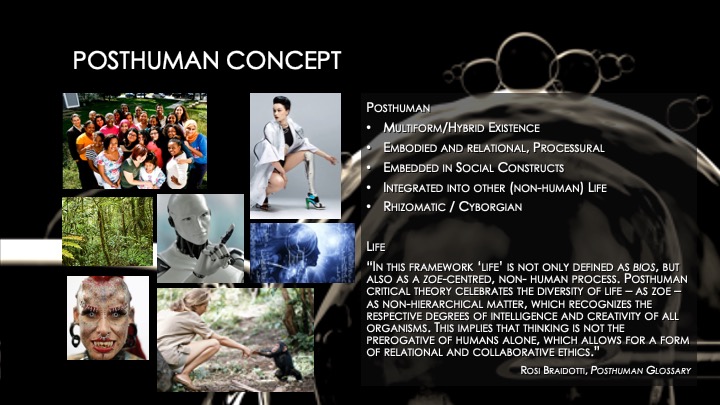
(5) instead the posthuman promotes the idea of a humanity that is embodied and embedded in social, cultural, technological, natural, hybrid networks, ever-changing and always relational to its current interactions. Posthuman subjectivity thus would be cyborgian and rhizomatic … it connects us with life that surrounds us, with the technologies that we use … in this sense, we are not just becoming posthuman, but we already are and have been for quite a while…
(6) A lot of what we consider science fiction has been about some form of the posthuman. Already in Mary Shelley’s Frankenstein we find the idea of creating life but then ultimately denying it the status of human. The monster, shunned by society but reading humanist classics, compares himself to the described humans, always lacking some aspects. Consequently, pondering his own state of being, he asks: ‘Who was I? What was I? Whence did I come? What was my destination?’ (Shelley 128). Similar questions about human nature are brought up time and again in other sf classics, from H.G. Well’s The Island of Doctor Moreau and its human-animal hybrids to Karel Capek’s Rossum’s Universal Robots and the conflation of man and machine … all of them share the idea that the boundaries and essences of human life can be challenged.
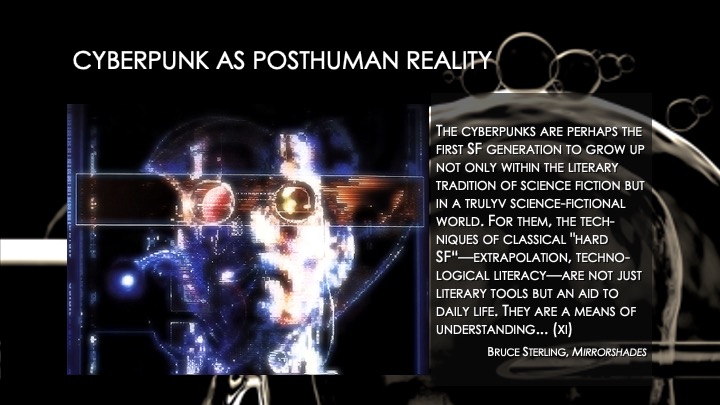
(7) But it took both critical theory and technological development a bit longer to come to what we might call the posthuman turn. Back in the early 1980s, a group of writers claimed to be the first generation to “grow up […] in a truly science-fictional world,” a world so full of technological wonder that they claimed one needed to use literary techniques to parse the realities of daily life—“extrapolation, technological literacy” became “a means of understanding” (Sterling, xi). The cyberpunks embraced key changes in technology and media of a late-capitalist world in the 1980s. Their fiction produced a truly posthuman vision of the future that has since become iconic and has lately been recognized to reflect a substantial part of our current status quo of reality.
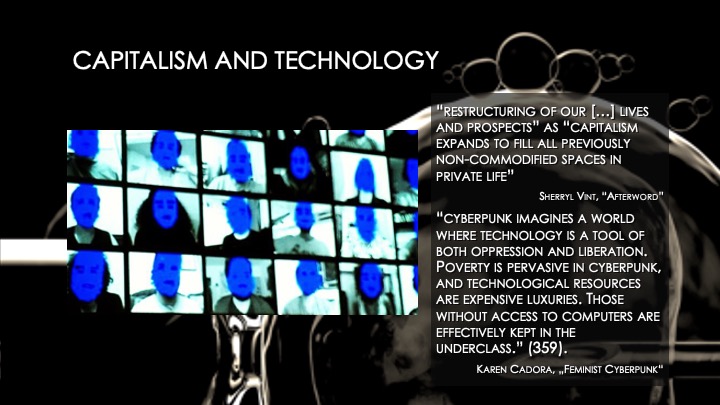
(8) As we can already see from this self-description, there is a strong link between posthuman technologies, economics, and power distribution: According to Sherryl Vint this nexus determines the “restructuring of our […] lives and prospects” as “capitalism expands to fill all previously non-commodified spaces in private life” (“Afterword” 232; 231). And Karen Cadora has pointed out that technology itself is the divisive instrument to uphold hierarchies of control.

(9) What I want to argue in the following then is that posthuman technologies are a site of engagement with “real subsumption,” as it concerns human subjectivity. Capitalist strivings to subsume body and mind can either be enhanced or hindered by technology and science fiction is a creative reflection of these conflicts. SF allows us to negotiate the cultural and social impact of posthuman technology and the individual costs of becoming posthuman.
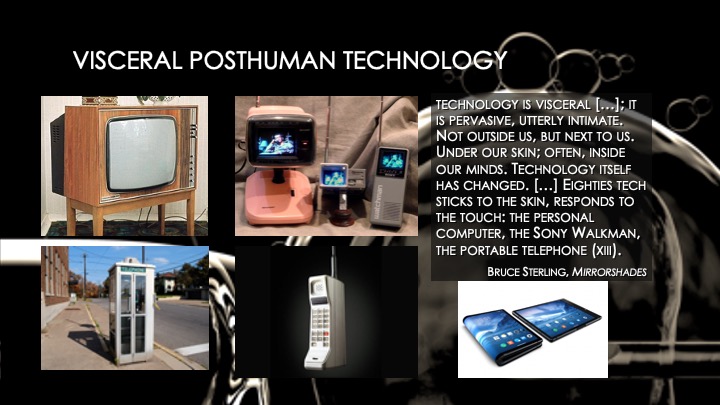
(10) What motivates cyberpunk aesthetics are drastically changing possibilities of science and technology—as Sterling makes clear 1980s “technology is visceral […]; it is pervasive, utterly intimate. Not outside us, but next to us. Under our skin; often, inside our minds. Technology itself has changed.”
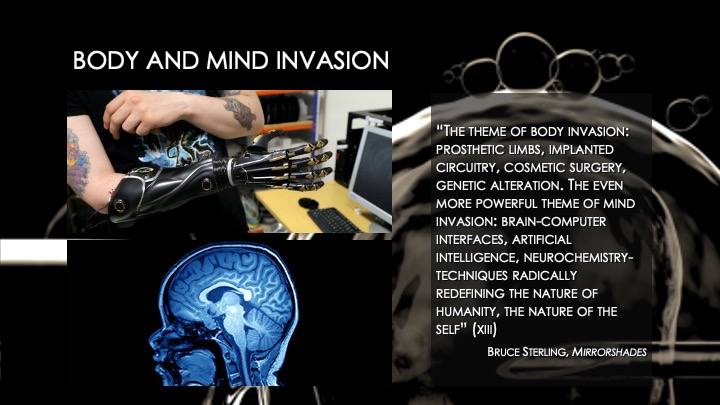
(11) Cyberpunk extrapolates this visceral technology, literalizing it as “under our skin” cyborg implants and new interfaces with computers “inside our minds.” Cyberpunk imagines technology invading the human: the themes of body invasion and mind invasion … redefining the nature of humanity, the nature of the self” (xiii).
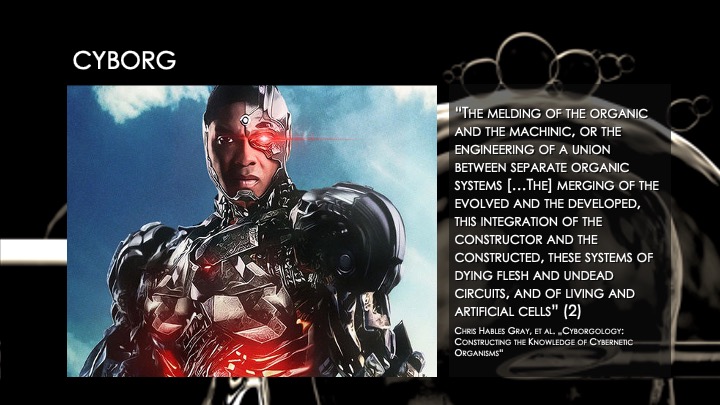
(12) So, the first posthuman technology that I want to talk about is the cyborg, the replacement of bodily parts by technological prosthesis. As an entity, the cyborg refers to the “melding of the organic and the machinic, or the engineering of a union between separate organic systems” (2) – as Chris Hables Gray argues. The cyborg is the invasion of technology into our lifeworld, it is representative of the growing insistence that without technology we are not capable, not fully functional.
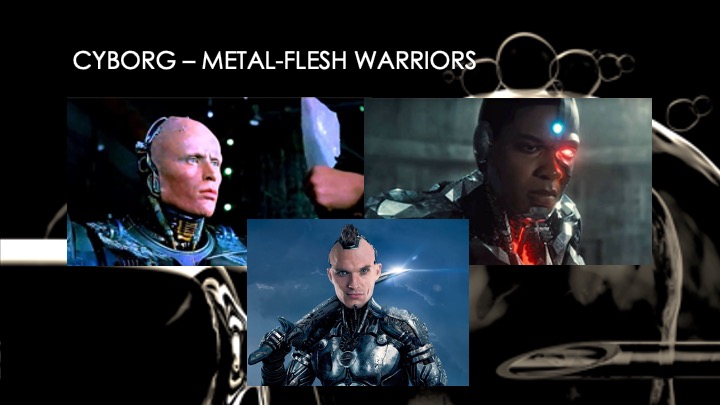
(13) The cyborg becomes representative of a fully-technologized, “’postbiological’ world,” as proclaimed by transhumanists such as Hans Moravec, who argue that the human body is a prison of flesh and blood—the world we live in conceived as ‘meatspace.’ This is how pop culture of the 1980s imagined the cyborg and how he remains in many fictions till today. For Donna Haraway, these cyborgs are “metal-flesh warriors,” techno-fantasies of power (“CaS” xiv). Their proliferation in action films aligns them with the 1980s and 1990s muscled figures of hypermasculinity (think Arnold Schwarzenegger, Sylvester Stallone, Jean Claude Van Damme…). Their cyborg bodies, whether machine or trained-to-be-machine, represent ultimate power over life and death. Bodies that are meant to withstand outside forces and still be in control. We can find a similar thinking at work in today’s militarized high-tech police forces and in drone technology, where new warrior types use technology to decide the fate of others, to give them an advantage, a superhuman ability, mostly linked with violence.
(14) What these cyborg warriors represent, and what Haraway argues aligns them with the military-industrial-complex, is the question of whom posthuman technoscientific objects belong to? If a cyborg is a war machine, in a capitalist world, who can claim ownership and who determines cyborg subjectivity? A scene from RoboCop makes clear how far bodies are subsumed by corporate and financial interest
(15) Film scene from Robocop…
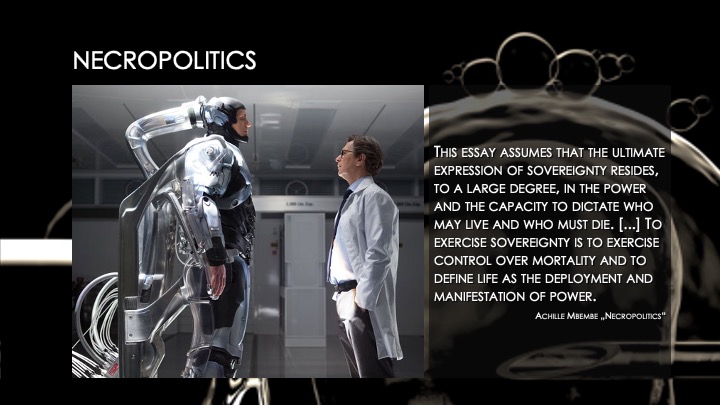
(16) In the film, the police have become subsumed by Omnicorp, a security firm belonging to OCP or Omni Consumer Products, a megacorporation that basically produces everything that can be produced. The police are helplessly understaffed and outgunned, especially in terms of access to technology. Omnicorp, on the other hand, has free access to technology and uses it to establish dominance and control over their domain, which in this case includes the human part of the police force. Consequently, they own the rights to Officer Murphy’s body and can subject him to any managerial decisions—a crude but effective example of what Achille Mbembe calls “necropolitics:” “the power and the capacity to dictate who may live and who must die” (11). Even though his biological brain is effectively a part of it, Murphy’s access to the posthuman technology of his own cyborg body is restricted; it is not “his” body; instead the decision of which power to grant him is made by others, as is the larger issue of whether Murphy is allowed to die.
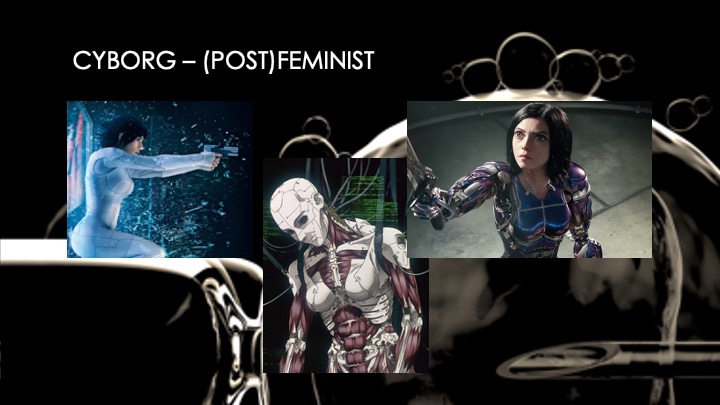
(17) Interestingly, especially in Japanese manga and anime, the figure of the female cyborg has a slightly different connotation. On the one hand, they similarly represent power and control, but their physique is much less oriented towards violence, but rather towards sexuality. Their superhuman strength and ability is counterbalanced by an emotional and contemplative side. They struggle, much more than their hypermasculine counterparts, with the question of what it means to be human. Major Motoko in Ghost in the Shell questions her subjectivity, unable to know how much human biology is left in her. She questions how much she is able to freely control her actions, how much a programming determines her life and death. By contrast, as Stacy Gillis has pointed out, these women are nonetheless “hyper-sexualised cyborgic female bodies” and thus “reduced to either sexualised or monstrous femininity” – they are defined as what she calls (post)femininity because they are powerful in masculine defined areas such as physicality or technology but represented as lacking certain feminine attributes to counter this, such as “a relationship, a child, a more attractive body, a stable parent figure and/or domestic skills” (7-9). Their struggle with these voids in their identity becomes their central motivation.
(18) Video from Alita…
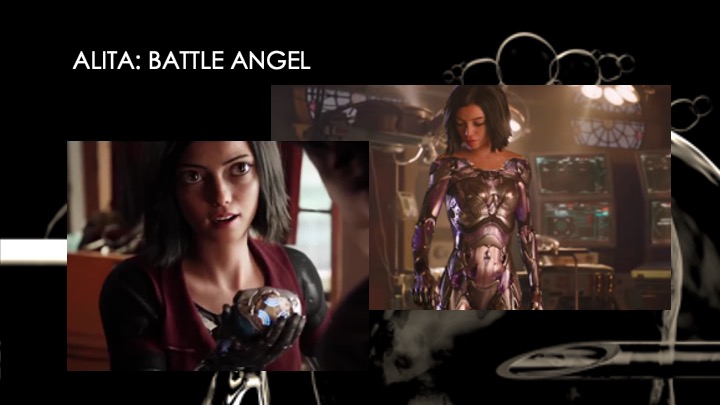
(19) Alita, for example, is strong and in many of the films action sequences shows her warrior qualities, nonetheless, she is also determined by her wish for human connection and recognition, wondering whether she will be accepted as human. In one key scene, she is literally offering her heart to the boy she loves. The central motivation for her actions, is that she is lacking both a stable identity and a relationship. But, she is defined by her mechanical body – identifies with it and through Dr. Ido gets labeled as a “powerful weapon,” effectively making her an object to be wielded.
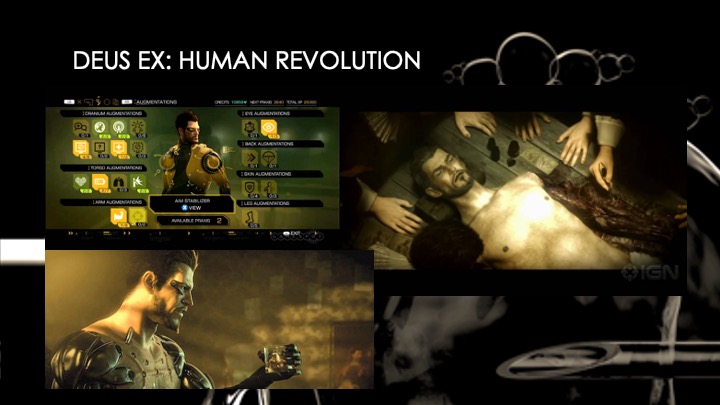
(20) The complexity of the issue, the cyborg as both militarized-object and hybrid-identity becomes apparent when necropolitical control is brought to bear on the cyborg, as in the video game Deus Ex: Human Revolution. Players take on the role of Adam Jensen, a security agent for the bio-medical corporation Sarif Industries. At the beginning of the game, Jensen is almost killed in a terrorist attack, but his boss David Sarif decides to save him by replacing most of his body with cyborg implants and prosthesis. During the game, Adam struggles with his augmentations, on a personal level knowing he would not have survived but nonetheless feeling forced into being a cyborg. In the game world, augs are a commodity, they are objects that can be traded and that need maintenance. But they are also a posthuman technology that grants their owner power, makes them stronger, more resilient, more perceptive. They grant advantages over unaugmented humanity. The main storyline of the game follows Jensen uncovering a conspiracy to control the world via necropolitical power – by developing a biochip implanted into any aug that grants power over the efficiency of the augmentation. While the game relies heavily on Adam being augmented and devotes a lot of game mechanics to boosting his abilities, one scene reveals the down-side of a necropolitical construction of the cyborg.
(21) Video from Deus Ex: Human Revolution
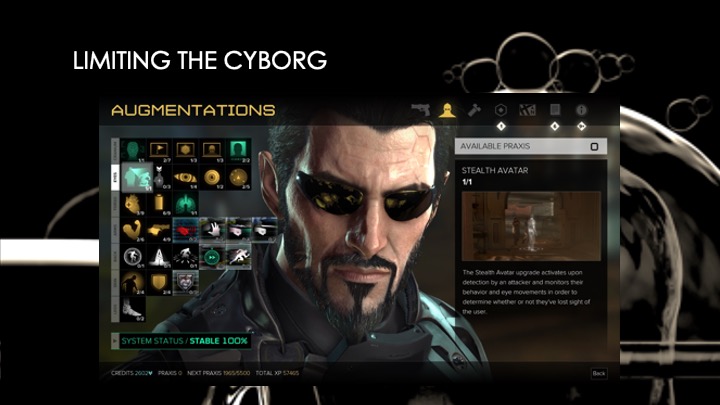
(22) In a capitalist world of the commodification of the body as technology, questions of ownership and control are at the heart of cyborgian embodiment and subjectivity. Adam’s superhuman abilities can easily be turned off by those in power of manufacturing and or maintaining the technology. Necropolitical power lies with those forces that own the technology, leaving the individual at their mercy. And here the game is generous, leaving Adam with unenhanced human agency, stripping him of the superhuman abilities. Under real subsumption, cyborg prosthesis could be powered down completely, leaving the person without movement, speech, vision or other enhanced faculties – as the chart here shows, this would include augmentations for his general health, visualized as a heart muscle, and his general stamina, visualized as a battery. Turning off a pace maker, artificial lungs or an enhanced digestive system would immediately kill a cyborg. These are repercussions of becoming-cyborg within a capitalist framework of necropolitics and real subsumption that are generally ignored by cultural representations, but that are here foregrounded in Deus Ex.
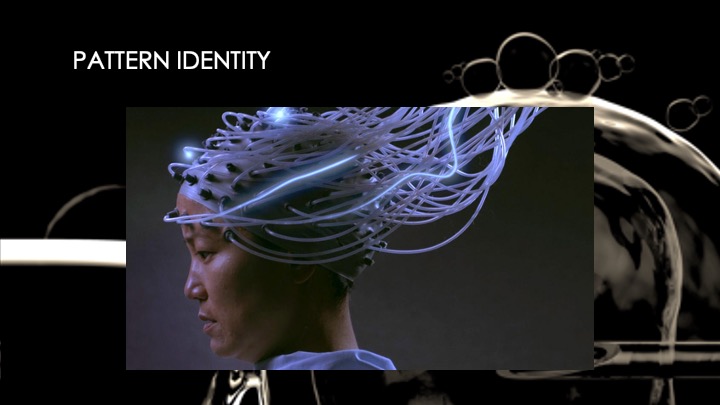
(23) In a sense then, the second posthuman technology that I want to discuss is even more prone to subsumption, because it does not just turn prosthesis into commodities but essentially the whole body. In Moravec’s vision, the best option to become posthuman lies in the “idea that a human mind can be transferred to a new body” (110), and here at best a synthetic body to circumvent biological limitations. In terms of subjectivity, he argues that the “essence of a person” is not defined by “the stuff of which a body is made” but rather “the pattern and the process going on in my head” – he calls this “pattern-identity” (177). Analyzing William Gibson’s Neuromancer (1984), Vint makes the point that cyberpunk similarly “appeals to the (impossible) desire to escape the vicissitudes of the body and occupy the place of selfmastery” (104). Yet, this ignores the possibility to become under subsumption exactly because of an embodiment within technology.
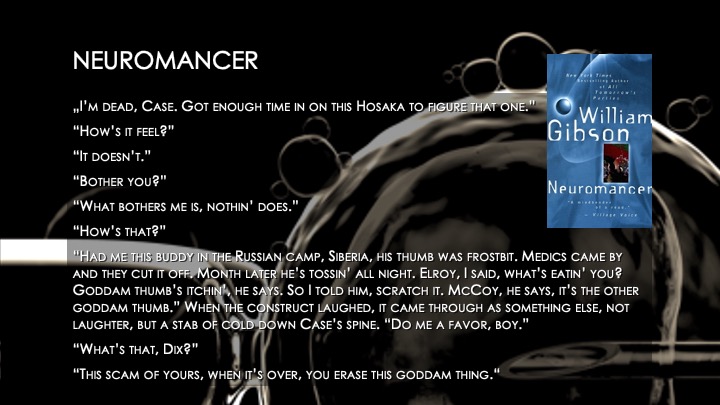
(24) In Neuromancer, we encounter a hacker named Dixie Flatline, or better, we encounter his “construct”, a recording of his brain. The construct is safely and physically stored for use in a vault, where it exists almost outside of time. Dixie later explains that he is aware of his embodiment: „I’m dead, Case. Got enough time on this Hosaka to figure that one.” But he also hints at not-feeling anything and being bothered by that lack – a phantom pain for emotional distress. In the end, he asks Case: “This scam of yours, when it’s over, you erase this goddam thing.“ Being non-embodied as a consciousness in a computer, Dixie is unable to change or engage in anything physical. He is literally trapped in a box and made to work for whoever owns the physical construct. It is a posthuman existence, but stunted in its subjectivity because it is lacking stable and controllable embodiment.

(25) In Neuromancer, Dixie’s consciousness transfer means that he cannot escape being commodified; his mind is trapped in a physical construct. But there are other issues with the conflation of human existence as computer code. In the young adult novel The Adoration of Jenna Fox by Mary Pearson, teenager Jenna Fox wakes up after a car accident put her into a coma. Because her whole perception of herself seems slightly off, she investigates the accident and her family’s actions surrounding it. She discovers having died. Her parents resurrected her in a synthetically created body with a 10% DNA sample and 90% bio-gel recreating her biological body. Her consciousness was transferred to this artificial body, but she realizes, her identity has been manipulated. Her parents made her more compliant and doctored her memories and her ability to revolt against them. In effect, her consciousness has been edited to her parent’s wishes. Because both the bio-gel and the consciousness recording are essentially objects, commodities, the options to manipulate it to specification is within the means of necropolitical power. As with Dixie, Jenna realizes that her consciousness has been awake and self-aware during the time in a computer storage unit, suffering in darkness because of her non-embodied existence. The threat to erase Jenna and reboot her with the recording is looming in the form of a computer in her parent’s closet.
Furthermore, not only is there a necropolitical threat from her parents, who own and control both her body and consciousness recording; the legal status of her artificial body is not fully resolved as legislation has banned replacing large portions of human tissue with bio-gel. Jenna’s physical body is illegal and the book leaves open the consequences of being found out, but one can assume that incarceration, experimentation, or termination might be possible options. All of which exemplifies how vulnerable synthetically created bodies can be within a system of necropolitical control.
(26) Moving, at least in part, from cyberpunk to biopunk, in the following the posthuman technology is no longer based in replacing biological body parts with artificial ones. If you will, the move has been from robotics to genetics. And yes, this is a simplification, but one necessary to keep within the frame of this talk. Similar to cyberpunk, biopunk is a science fictional mode describing posthuman technology and its consequences, but with a shift in focus and outlook. Biotechnology has come to sit alongside information technology to form the dual focal points of posthuman technology. I would argue that with the Human Genome Project finally mapping our DNA in 2000, biology has become a, if not the central component of realizing our newly posthuman existence. In terms of the cultural formation then, genetic engineering, tissue cultures, cloning and other biotechnological innovations have entered mainstream imagination and take on a bigger part of how the posthuman is represented.

(27) An even more complex depiction of a world in which bodies have become exchangeable commodities is the Netflix series Altered Carbon, based on the novel of the same name by Richard Morgan. In the world of the show, human minds are recorded in an implanted alien technology, the so-called stack. With this technology, a stack can be transferred into many different forms of embodiment, so-called sleeves. These can be naturally born, vat grown in a cloning facility, illegally bio-printed from sampled DNA, or fully synthetically created. There is even the choice to spin up the stack in any kind of virtual environment – as discussed with Neuromancer. The choice of bodies is only limited by one’s economic means, as each option comes with a price tag. Bodies are ultimately commodities through which power differentials are expressed.
(28) As I have argued throughout this talk, in this world everything is subsumed by capitalist power, and even human bodies, down to the last strand of DNA, become the object of necropolitical control through the abilities granted by the stack-technology. Altered Carbon drives the inequality of power to the extreme, sending “socioeconomic stratification into overdrive, creating dire new realities for the poor […] while simultaneously producing an elite upper-class,” as Devon Maloney has argued. This elite, called Meths (in reference to the biblical Methuselah, hinting at their unnaturally long life-span), treats bodies as a resource to be used for personal entertainment and gain. They live high above everyone else; literally above the clouds, as much as metaphorically, without the physical limitations to their embodied existence. Laurens Bancroft and his wife Miriam, for example, keep a number of grown clone bodies at hand, should their current body fail and need to be replaced.

(29) In the show, a company named Psychasec provides any and all services that Meths should want – growing new and attractive bodies, storing and securing clones, providing temporary sleeves for long-distance travel. In one advertisement for the company, a young female sleeve smiles at the potential customer and asks him to “put your wife in me” … proving not just the commodification of bodies but also a still rampant misogyny that sees women as objects; a fact also portrayed by the show’s gratuitous nudity, frequent sex scenes, and violence against women. In this vein, Psychasec also offers to enhance sleeves via genetic engineering, for example producing female sleeves that produce sex drugs on command. Men, on the other hand, are able to order sleeves with a genetical cocktail that makes them “combat-ready” fighting machines just like the cyborgs discussed earlier. When you have the money, biomedicine is able to provide any kind of specialized body.
(30) In a hypercapitalist society, though, technology and resources also produce a divide and entrench systems of inequality. As James Caccamo has argued, “the digital divide will no longer be a social reality but will be written into our bodies and minds“ (209). Caccamo points out that “radical inequality results from the posthuman development process” and that it will entrench or even accelerate “the injustices that characterize our contemporary society” (209). For the poor and disenfranchised, the body they are born with becomes one of the few, if not the only commodity to trade with. In Altered Carbon this is most poignantly demonstrated by the penal system. In reality, already a necropolitical tool used to generate revenue for private owners, the TV series makes literal what is so far only figurative: Convicted criminals become the property of the penal system, their stacks are stripped from their bodies and “put on ice,” while their sleeves are reused and available for sale. When prisoners are released, or when victims of crime get a free sleeve as “restitution”, the state pays for the body, providing “what they have on hand. Broken down crap […] Prisons lease out the good sleeves for profit” (“Out of the Past”, S01E01).
(31) Video from Altered Carbon
(32) In this scene, what is meant as “victim restitution” is adding insult to injury of those that cannot afford the upgrade; the family is left with the traumatic experience of a child in an older woman’s body. But in the show, another group feels much more the subsumption and commodification of bodies. Sex workers provide their bodies to the wants and needs of their clientele. Whereas virtual reality could provide an outlet for sexual fantasies, in the world of Altered Carbon, physical sex is seen as more desirable and is thus a better-paid service. Meths such as Bancroft, for example, use sex workers to act out violent fantasies, sometimes killing the (biological) sleeves of the girls he stays with. But, as one sex worker argues: „He’s one of the good ones. If he breaks it, he buys it. […] You know, if he accidentally kills a girl he buys her an upgraded sleeve” (“Fallen Angel”, S01E02). The sex workers see their bodies as commodities to trade with, most of the time the only commodity they have to offer.
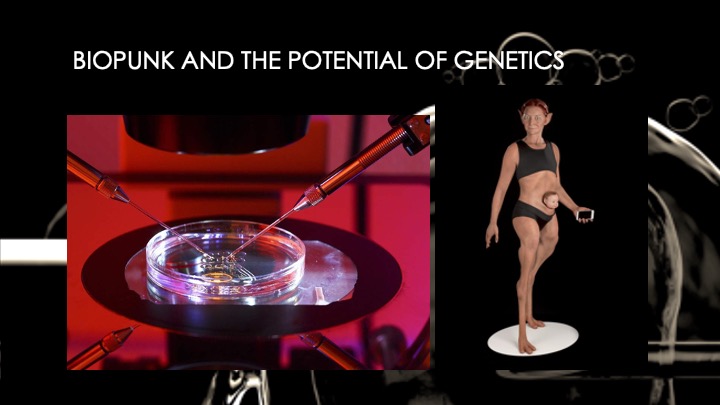
(34) But biopunk does not just offer us an endless supply of cloned or manipulated human bodies to inhabit via consciousness transfer. Rather, the posthuman technology of genetic engineering promises so much more flexibility on how we imagine ourselves to be or what we might accomplish in changing the biology of life around us. We could change human DNA and thus go beyond the biological limits that transhumanist thinking proclaims our current embodiment imposes upon us. Picking up the idea from 1950s science fiction and its concept of “pantropy”, new technological or environmental challenges could be faced by changing the human body in its DNA make up. If the world becomes scorched due to climate change, designing humans with UV resistance might be seen as a solution.

(35) Margaret Atwood, for example, proposes this scenario in her novel series consisting of Oryx and Crake, The Year of the Flood and MaddAddam. Atwood’s series deals with a devastated near future in which climate change has made large parts of the earth uninhabitable: Temperatures and sea levels rose, fertile lands became deserts and humanity’s energy hunger depleted most natural resources. The elite population now lives in class-segregated communities and revels in bacchanalian ignorance and consumption, while the masses barely survive in squalor and constant fear of disease, crime, and natural catastrophe. Nation states have given way to global corporate rule, and biotechnological progress and its capitalist consumption have had a major impact on society and the environment. In this future, renegade scientist Crake genetically engineers a plague that wipes out humanity, which he sees as faulty and destructive. As an alternative to the human species, Crake genetically engineers a race of posthumans that is supposed to repopulate the earth after the demise of the faulty species. Crake designs his Crakers through splicing human DNA with those from other lifeforms, engineering what he considers improved features, and editing out negative ones: The Crakers are docile and vegetarian. They can resist high levels of UV radiation, repel insects with a citrus smell, fend off predatory animals via marking their territory, and come into heat in regular intervals in order to consensually mate in groups, favoring communal social interaction and not pair-bonding (363ff.). Not only are the Crakers, as Gerry Canavan argues, “a hyperbolic version of the fantasy that we might turn back the clock and begin history anew” (152), but they are also better adapted to the new environment of the Anthropocene.
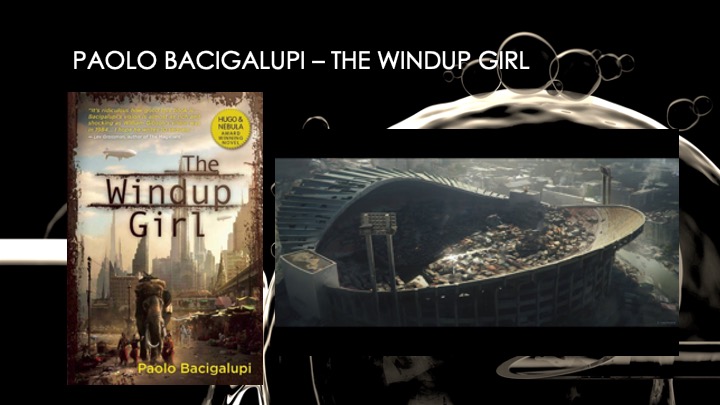
(36) A similarly uninhabitable world due to human ignorance and reckless actions is presented by Paolo Bacigalupi in The Windup Girl, in which the world has undergone drastic economic, political, and ecological changes. After a period of ‘Expansion,’ energy production through fossil fuels collapsed completely, leading to worldwide ‘Contraction’: Global transport, industrial production, and computing have become impossible. During the Expansion, genetic engineering technology has created corporate interest in food patenting. This lead to corporate wars, in which ‘calorie companies’ genetically created plagues and pests that destroyed unpatented food, so that they could then distribute their own disease-resistant strains of the same food for large profits. Global warming caused sea levels to rise and the planet’s environment was almost destroyed. In the novel, a posthuman species is introduced, created solely for utilitarian purposes, a species of servants, soldiers, and workers. These New People are genetically altered to serve specific functions and to address the demographic changes in Japan, where too few young need to care for too many old. They are endowed with superhuman characteristics, such as perfect appearance – symbolized in their flawless skin without pores –, augmented senses, extreme speed, and near-perfect hand-eye coordination. In order to control such superhuman beings, New People have been created with fail-safe mechanisms such as genetically forced obedience, sterility, and recognizable movements, the eponymous windup motions. What connects New People and Crakers is that both are genetically designed objects, created by a company to be sold as a commodity. They are replacement children to address the needs of an infertile parent generation. In both cases, though, the design of these posthumans realizes a need to adapt to new climates, to resist environmental changes and to exceed the biological limits that makes it harder and harder for humans to stay alive in their own habitat. New People, for example, are resistant to the genetically designed diseases and plagues that run rampant among the human population. And Crakers can easily live with a depleted UV shield due to a lack in the ozone layer. And with this, both represent a shift in critical posthuman thinking … one that sees posthuman technologies not merely as tools of subsumption, but also as solutions for a future beyond capitalism, even beyond the human itself. Both capitalist societies and their worlds are dying, Atwood’s and Bacigalupi’s; they are trying to keep up the need for commodification. And both are disrupted through genetics and their unforeseen consequences, in the end leaving the posthuman species in control. According to critical posthumanism then, it might be possible for life to continue and thrive, even if we – the human species we currently are – might not be part of this life.
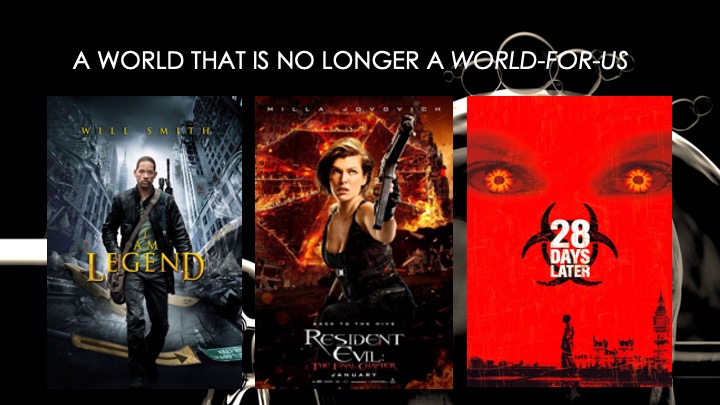
(37) Taking this idea even further, I would like to point out one more posthuman technology, or better said, a variant of the technology of genetic engineering that I already discussed. It is not necessary for us to change our own DNA to have an impact on the world we live in, social or natural. As discussions of the Anthropocene have shown us, simple technologies like agriculture or irrigation can change the make up of the environment we live in. The consequences of technology can be far-reaching and genetic engineering is at the heart of some of the most radical changes proposed for the future. As an example, I want to point out a trend in zombie films since 2000 that imagines the manipulation and mutation of viruses. In films such as I am Legend, the Resident Evil seriesor 28 Days Later, scientist are eager to explore the genetics of viral organisms. In I am Legend, it is a gene therapy for cancer that mutates and causes the death of millions and the conversion of the others into Dark Seekers, a mix of zombie and vampire essentially taking over the world and killing the remaining humans. In 28 Days Later, animal experiments on the so-called Rage virus backfire when the virus breaks the species barrier and infects all of Britain, causing humans to become aggressive and kill each other. And finally, in the Resident Evil series, an evil corporation weaponizes a viral gene therapy for muscle dystrophy into a killer virus, that unfortunately reanimates the dead as flesh hungry zombies. What all these examples have in common is a motivator for the gruesome action in genetic engineering, not of humans but of viruses. In all of them, a few remaining survivors struggle to get back to their idea of civilization but in the end have to realize that humanity has to make way to a forceful new posthumanism. In the words of Jason Wallin, the zombie functions as a cultural confrontation “with the alien materiality of a world that is no longer a world-for-us” (64).

(38) One last example: In The Girl with all the Gifts, a variation of the ant-attacking fungus Ophiocordyceps unilateralis has broken the species barrier and infected humans – the film suggests, it might have been a military experiment in genetics. As with the famous “zombie-ants”, the fungus wraps around the brain of the human host and then hi-jacks its behavior, in order to spread the fungal infection. Ants are driven to higher ground, high up on trees, where they die when the fungus grows out a stroma, which encases its sporangia (here in the picture). The stroma bursts open and spreads the sporangia across the wind to infect other ants. With humans, there is a similar process. Humans get turned into “hungries”, wanting to spread the fungal infection via fluid transfer by biting. The fungus grows on – and in – the human host, which remains dormant until it senses a possible other host that can be infected. When it does, the hungry attacks.

(39) At this stage, hungries are simply zombies by another name, undead in their loss of human agency, at the same time vegetative fungal host and urge-driven animal hunting, a threat to human life. The film’s cast, scientists and soldiers, enact a resistance to the new order the hungries represent. The military men erect barriers and destroy hungries, as Wallin posits, on the “presumption of a stable, human-centered world … largely fashioned from the perspective of anthropocentric separation and dominion” (57). The zombie is other to the human, a different ontological category. Consequently, as long as we can keep a barrier between zombie and human any and all violence is sanctioned by this presumed hierarchy of life.

(40) But the film blurs this line, crosses that barrier and problematizes the category of “hungry” by introducing a group of children, who carry the virus but are more controlled. Studied and experimented upon, the children are revealed to have human cognitive abilities and emotions. Dr. Caldwell, the lead scientist believes the kids to be another stage of the fungal infection, coldly studying and dissecting them. She argues that these are not kids at all, but rather that the fungus “presents as children” and, in fact, “does their thinking for them”. She believes the fungus uses the host to mimic human behavior and that the children are not alive, but, like the ants and the hungries, driven by the fungal urge to reproduce.
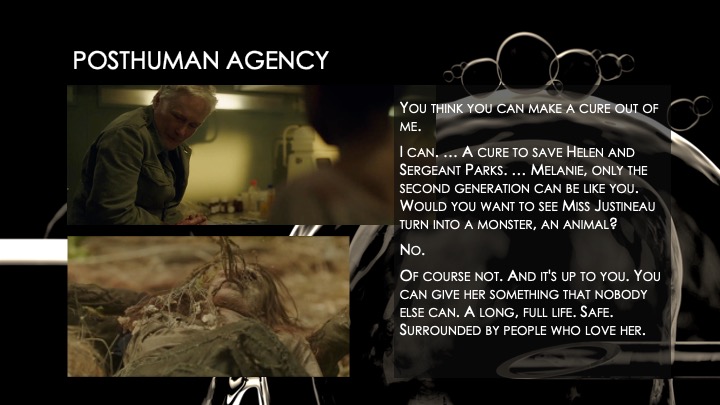
(41) Over the course of the film, we sympathize with Melanie, one of the children, because she is clever, very articulate, observant, and emotionally engaged. When the base where the children are kept is attacked, Melanie and a group of human survivors escape. On the road, they realize that Melanie (and the other children) have a symbiotic relationship with the virus, rather than the parasitic one that dominates the hungries. The film asks uncomfortable questions about agency and human nature and established Melanie as a focal point exactly because she is “unlike anything that has ever existed before.” Caldwell realizes, that Melanie holds the key to cure the virus, to return to what she considers normalcy and stability. Melanie, though, is a creation of a posthuman technology, not purposefully engineered but a consequence of it nonetheless. Due to her status as “cure”, her agency and subjectivity are limited. She is treated as a commodity, a walking scientific break-through. But using Melanie in this way, would kill her. Science here becomes necropolitical; the ruling system is anthropocentric and driven by humanist conceptions of exceptionality, Melanie’s death would be a means to an end. The posthuman is not granted subjectivity, and access to technology is hegemonically skewed. Over the course of the film though, Melanie learns about her status and the power it holds.
(42) Video from The Girl with all the Gifts
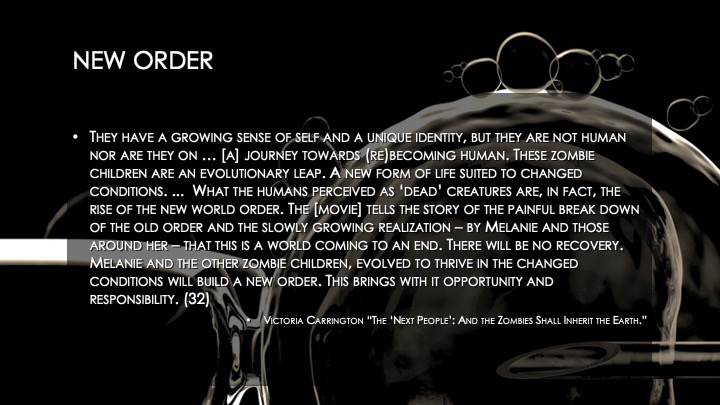
(43) In the end, Melanie represents a posthuman society that might supersede and replace the human. When she realizes her own posthuman subjectivity and the toxic hierarchies at work in this old world order, she claims a new thinking, a new position. Melanie dramatically points us to our own complicity with the old world: “why should we have to die for you to live?” … As Victoria Carrington has pointed out, the second generation of hungries is neither human, nor zombie – instead they are posthuman, and not on a „journey towards (re)becoming human. These zombie children are an evolutionary leap. A new form of life suited to changed conditions. … What the humans perceived as ‘dead’ creatures are, in fact, the rise of the new world order.“ Melanie goes out into the night and decides to release the spores from the pods – a wave of the fungus carried by the wind, infecting the rest of humanity and clearing the slate for the posthuman.
(44) Video from The Girl with all the Gifts Ending
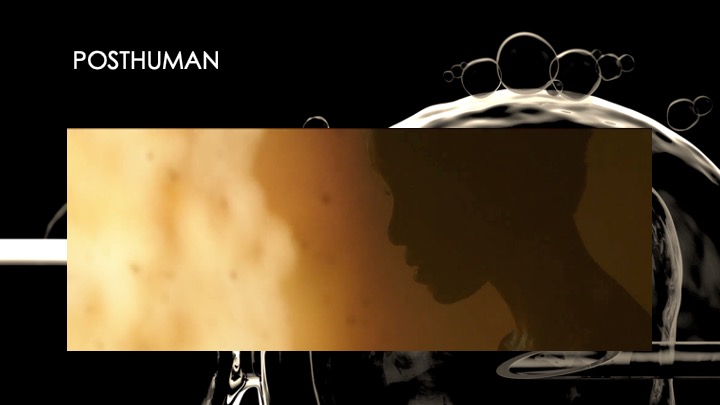
(45) When confronted with the posthuman decision to live, the old order – dying from the spores – rightly believes the world to end. What the soldier doesn’t realize is that it is only ending from his anthropocentric world view … from a critical posthumanist perspective, we might assume the opposite: “It’s not over. It’s just not ours any more.”
So, in closing, one might wonder what posthuman technologies mean to us … are they transhumanist fantasy fulfilment or are they a threat to what we consider a stable order of being. I hope to have shown that posthuman technologies run the risk of entrenching divisions in our conception of the human, that they enhance injustices due to necropolitics and real subsumption. But I hope, that I have also shown that they present a possibility for resistance and thinking about the future that might lie beyond us and beyond the concepts we have held as normal for so long. Let’s hope that there is a posthuman future, for us or for whatever comes next.
